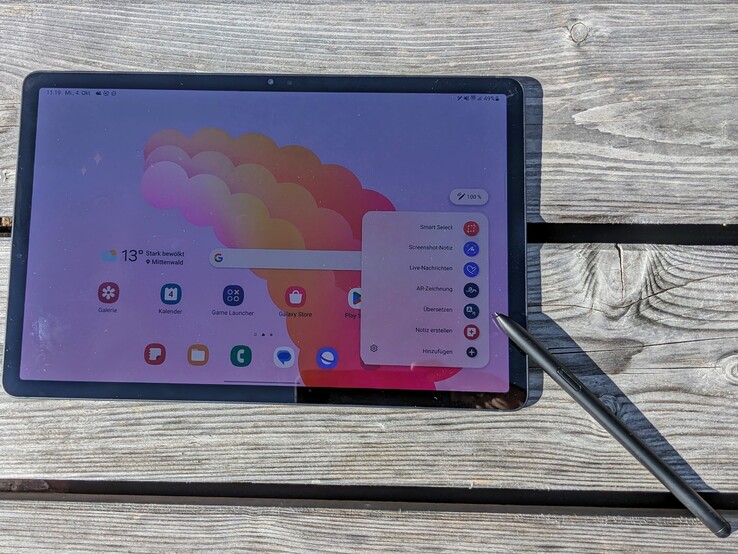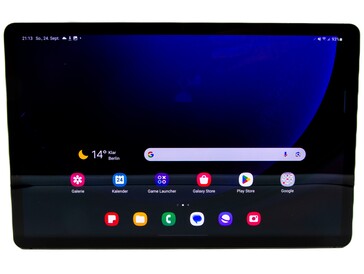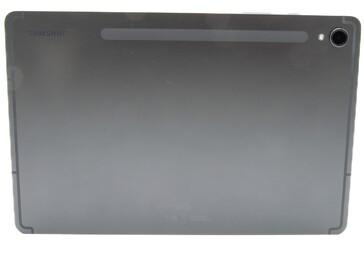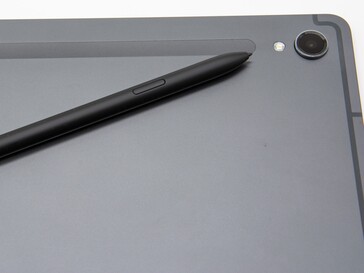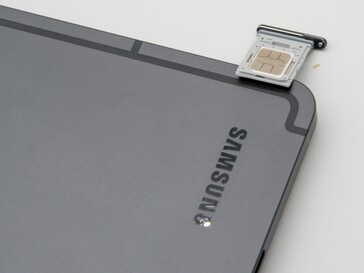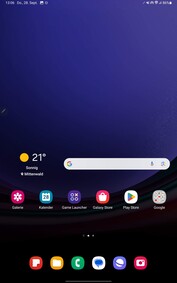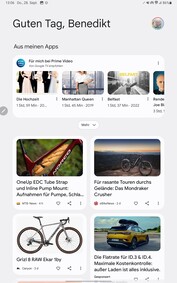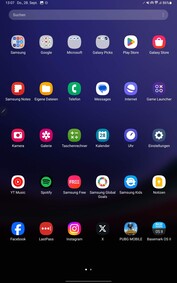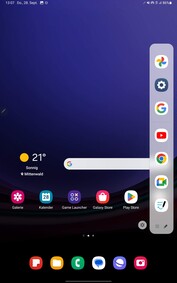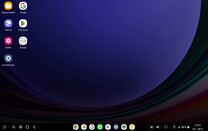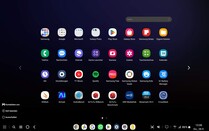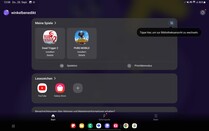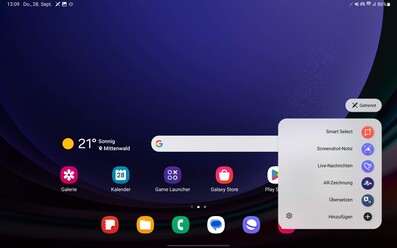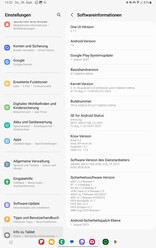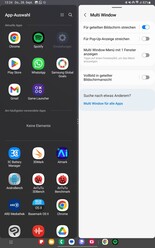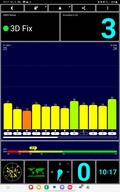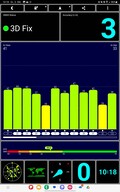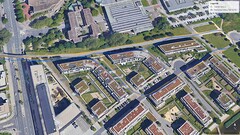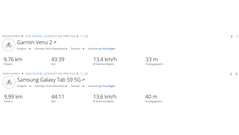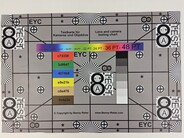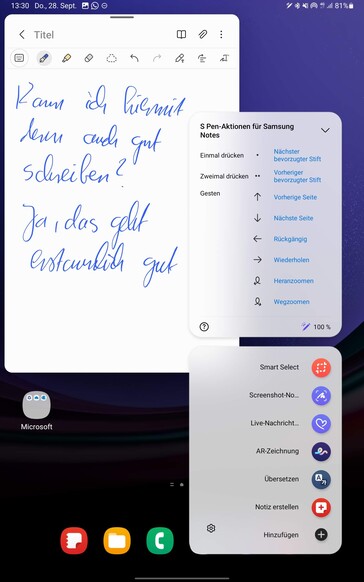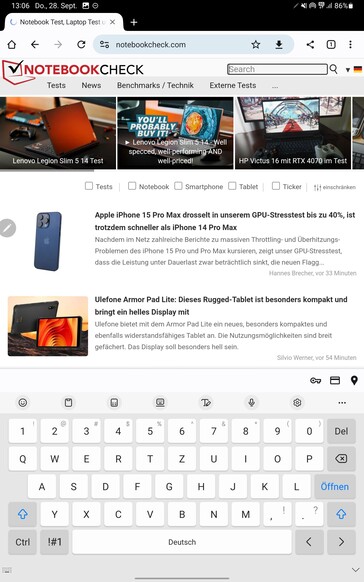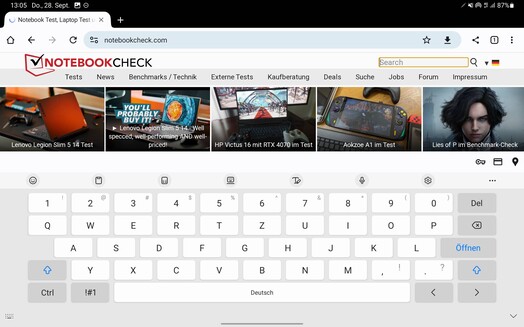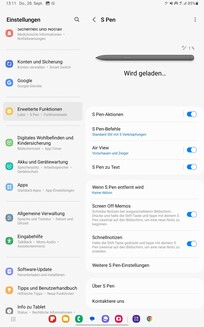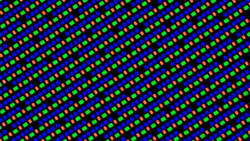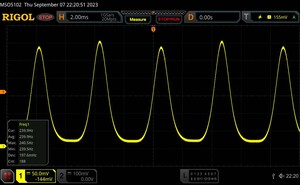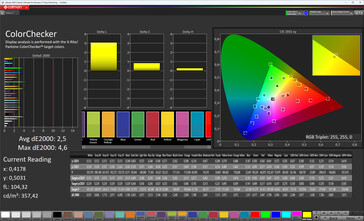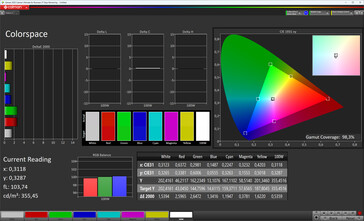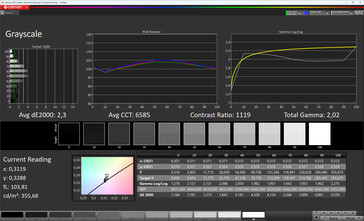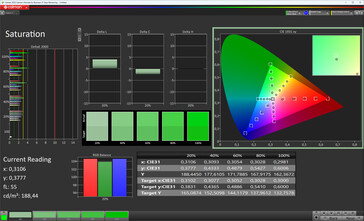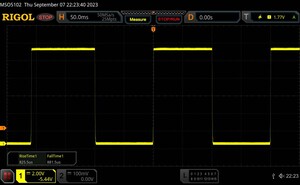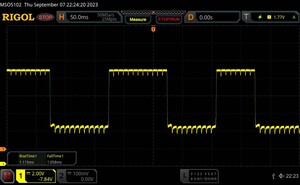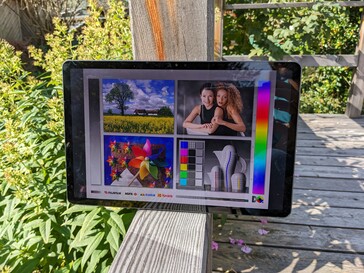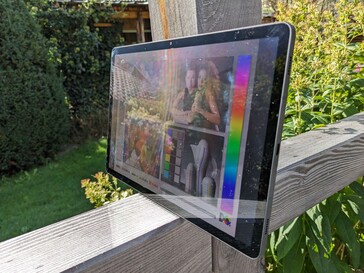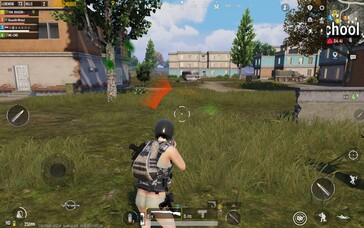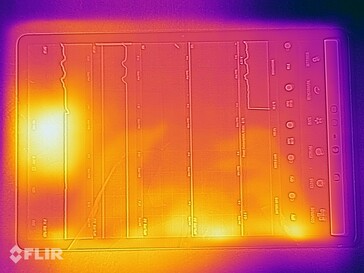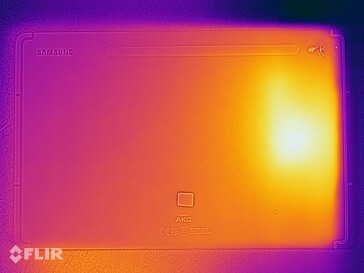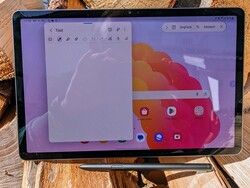Samsung Galaxy Tab S9 5G tablet review: Powerful all-rounder with OLED
The Galaxy Tab S9 series is Samsung's modernized high-end tablet ensemble. As usual, the new Galaxy S tablets are available in three sizes. Alongside the normal, 11-inch Galaxy Tab S9 of this review, Samsung also offers the larger, 12.4-inch Galaxy Tab S9+ and the 14.6-inch Galaxy Tab S9 Ultra.
All three devices are available in Wi-Fi and 5G versions. The Galaxy Tab S9 comes in two configurations, either with 128GB storage and 8GB RAM or 256GB storage and 12GB RAM. More storage is reserved for the larger siblings. Samsung offers the tablet in two colors, namely Graphite and Beige. Our test device is the larger storage configuration, 5G and the Graphite color.
Prices for the Galaxy Tab S9 start at $764.15 (128 GB, Wi-Fi only).
Possible Competitors in Comparison
Rating | Date | Model | Weight | Height | Size | Resolution | Price |
|---|---|---|---|---|---|---|---|
| 90.9 % v7 (old) | 10 / 2023 | Samsung Galaxy Tab S9 5G SD 8 Gen 2 for Galaxy, Adreno 740 | 500 g | 5.9 mm | 11.00" | 2560x1600 | |
| 90.2 % v7 (old) | 06 / 2022 | Samsung Galaxy Tab S8 5G SD 8 Gen 1, Adreno 730 | 507 g | 6.3 mm | 11.00" | 2560x1600 | |
| 92.5 % v7 (old) | 11 / 2022 | Apple iPad Pro 11 2022 M2, M2 10-Core GPU | 466 g | 5.9 mm | 11.00" | 2388x1668 | |
| 91.7 % v7 (old) | 03 / 2022 | Apple iPad Air 5 2022 M1, M1 8-Core GPU | 461 g | 6.1 mm | 10.90" | 2360x1640 | |
| 89.3 % v7 (old) | 09 / 2023 | Google Pixel Tablet Tensor G2, Mali-G710 MP7 | 493 g | 8.1 mm | 10.95" | 2560x1600 | |
| 89.1 % v7 (old) | 03 / 2022 | Lenovo Tab P12 Pro SD 870, Adreno 650 | 565 g | 5.6 mm | 12.60" | 2560x1600 |
Case - Samsung Galaxy Tab S9 is slim and stable
Samsung uses an aluminum chassis for the Galaxy Tab S9 series, which is divided by antenna strips at the edges. There is a slight groove on the back in which the included S-Pen is magnetically held in place and charged.
Unlike its larger siblings, the normal Tab S9 has only one camera on the back. This protrudes clearly from the thin chassis. Nevertheless, inputs are possible when the tablet is placed on the table; only in the lower left corner do inputs lead to wobbling.
The four speakers are located on the two short sides of the device. The case feels very high-quality and stable. Bendng the tablet is not possible and it does not emit any noise, even under load. The case is angular, which is especially noticeable when gaming and holding the tablet at the same time. Samsung has made the display edges pleasantly narrow and even.
The power button and volume rocker are on the top. Both buttons have comfortable pressure points, but the power button is a little loose. Ports for the corresponding Samsung accessories are provided on the bottom. The display is protected by Corning Gorilla Glass 5.
Equipment - IP68 for the Galaxy Pad S9
Samsung installs Qualcomm's currently fastest SoC, the Snapdragon 8 Gen 2 for Galaxy, in the Galaxy Tab S9. Our test device also has 12 GB of RAM and UFS 4.0 storage. Storage can be expanded with a microSD card.
Bluetooth 5.3 is on board and the USB-C port supports USB 3.1 Gen 1, which in turn supports the exFAT format, but can only read NTFS. NFC is not built into the Galaxy Tab S9. Instead, Samsung has had the tablet IP68 certified for the first time. The Tab S9 comes with the S-Pen, which allows for pen input. In addition to the pure pen function, the S-Pen is capable of gestures that are transmitted via Bluetooth.
microSD card reader
Unlike many competitors such as the Apple iPad 11 Pro or the Google Pixel Tablet, the storage on the Samsung Galaxy S9 can be expanded. The tablet supports memory cards up to 1 TB in size and supports the exFAT format. In tandem with our AV PRO microSD 128 GB V60 reference card, the S9 Pro achieves the same transfer values as its predecessor, the Galaxy Tab S8.
Data transmission speeds are thus significantly faster than the Lenovo Tab P12 Pro. In addition, the transmission remains stable and shows no dips in testing.
| SD Card Reader - average JPG Copy Test (av. of 3 runs) | |
| Samsung Galaxy Tab S8 5G (Angelbird AV Pro V60) | |
| Samsung Galaxy Tab S9 5G (Angelbird AV Pro V60) | |
| Lenovo Tab P12 Pro (Angelbird V60) | |
Cross Platform Disk Test (CPDT)
Software - Long support for the Samsung tablet
The Samsung Galaxy Tab S9 ships with Android 13. Samsung uses its own One UI interface, of which 5.1.1 was the most up-to-date version during our review. After downloading all preinstalled apps, 40 GB of storage space is occupied ex works.
Many apps from Samsung, Google and Microsoft come preinstalled, including duplicate apps such as Calendar or the photo display. Apart from the software of these large companies, only Spotify is preinstalled.
As with the Galaxy S smartphones, Samsung also promises four major updates and five years of security updates for the Galaxy S tablets. However, the devices do not receive security updates monthly, but quarterly. The security patch from August 2023 was installed on our test device.
The Galaxy Tab S9 supports Samsung DeX, which allows the device to be put into desktop mode. Connected to a screen, the tablet can be used even more effectively. In combination with a mouse and a keyboard, the Tab S9 becomes a functional work device. The working speed is high, operation in DeX mode is possible via the touchscreen or the S-Pen, and no additional input devices need to be connected.
Communication and GNSS - 5G and WiFi 6E on the Galaxy Pad S9
The Samsung Galaxy Tab S9 is equipped with the latest wireless connections, supporting both WiFi 6E and cellular 5G. The transmission rates are also impressive. In conjunction with our Asus ROG Rapture GT-AXE11000 reference router, the Tab S9 is at the top of the comparison field in the 5 GHz range. The transmission is also quickly established and stable.
Although the tablet supports Wi-Fi 6E, it was unable to establish a Wi-Fi 6 connection with our reference router in our tests. The is likely to be solved with a software update soon. Mobile data reception is good. The Galaxy Tab S9 supports several LTE bands and 5G bands. The tablet's reception is also solid when on the move - for example, on a train. Dual SIM is supported, which is implemented with a physical SIM and an eSIM.
| Networking | |
| iperf3 receive AXE11000 | |
| Samsung Galaxy Tab S9 5G | |
| Google Pixel Tablet | |
| Apple iPad Air 5 2022 | |
| Lenovo Tab P12 Pro | |
| Samsung Galaxy Tab S8 5G | |
| iperf3 transmit AXE11000 | |
| Apple iPad Air 5 2022 | |
| Samsung Galaxy Tab S9 5G | |
| Lenovo Tab P12 Pro | |
| Samsung Galaxy Tab S8 5G | |
| Google Pixel Tablet | |
| iperf3 transmit AXE11000 6GHz | |
| Samsung Galaxy Tab S8 5G | |
| Apple iPad Pro 11 2022 | |
| iperf3 receive AXE11000 6GHz | |
| Samsung Galaxy Tab S8 5G | |
| Apple iPad Pro 11 2022 | |
Samsung has installed a GNSS module for all common satellite systems in the Galaxy Tab S9. However, the device only establishes a mono connection, which is established quickly and is sufficiently accurate both indoors and outdoors.
To test the tablet's real world tracking capabilities, we took it along with a Garmin Venu 2 on a bike ride. The Tab S9 records the route taken, but differences become particularly clear in curves. Nevertheless, navigation via Google Maps, for example, is possible without issue.
Cameras - Single camera for the smallest S9 tablet
Unlike its larger siblings, the normal Galaxy Tab S9 only has one camera on the back. It offers a maximum resolution of 13 MP and is flanked by an LED flash. The resolution cannot be changed in the camera app. On the other hand, Samsung offers options such as a portrait mode, various filters, AR functions and a Pro mode.
This allows you to manually set the white balance, aperture and ISO. Although the front camera is equipped with 12 MP resolution, the Pro mode and AR Zone can only be used with the main camera.
The results of the cameras are solid in everyday use and are perfectly ideal for snapshots, especially in good lighting conditions. The portrait mode also works reliably. The software reliably recognizes and processes texts and QR codes. However, the camera reaches its limits when zooming in and taking night shots. Little light leads to image noise and some areas of the image still remain too dark. But for a tablet, the camera performance is really good.
The tablet can record videos in maximum UHD and the FPS is limited to 30 in all resolutions and with both cameras. What we particularly like about the videos is that the sound recordings are clear and deliver full quality sound without any background noise. In UHD there is slight image noise when there is movement in the video, which is eliminated in HD recordings. The video stabilization is good and the autofocus also works quickly and reliably.
For videos, Samsung also offers a Pro mode for the main camera with the same range of functions as for photos. There are also additional functions such as slow motion recordings and portrait videos.
Image comparison
Choose a scene and navigate within the first image. One click changes the position on touchscreens. One click on the zoomed-in image opens the original in a new window. The first image shows the scaled photograph of the test device.
Plush toy rabbitLake5x zoomLow lightThe sharpness of the Galaxy Tab S9's photos are good. Although it diminishes somewhat in the peripheral areas of the pictures, it is at a usable level. The color deviations are also okay, at least in good lighting conditions. The Samsung software brightens the colors too much, which is particularly noticeable in darker greens.
In controlled low light (1 lux), camera performance drops sharply. Colors are barely discernible and the sharpness cannot be evaluated because the image is too dark.
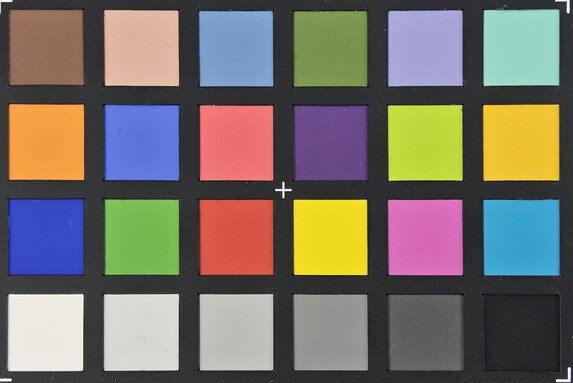

Accessories and warranty - Samsung omits the power supply
The scope of delivery of the Samsung Galaxy Tab S9 is very straightforward. In addition to the tablet, the packaging contains the S Pen, a USB-C cable, a quick-start guide and a SIM pin. A power supply is missing, as are replacement tips for the S Pen.
Samsung offers Samsung Care+ for the Galaxy Tab S9. This offers coverage for accidental damage (i.e. drops, spills and mechanical breakdown) via two payment options: $5/mo (cancel anytime) or $79 for two years. This can be upgraded to Samsung Care+ with Theft and Loss for $10/mo or $189 for two years. Terms and conditions differ slightly for residents of NY, who should double check via the link provided.
Samsung provides a 24-month warranty on tablets in Germany at no additional cost. This does not include the battery, which is covered for 12 months. These terms may differ in other countries, so interested buyers should double check before purchasing.
Input devices & operation - Galaxy Tab S9 with vibration motor
Samsung uses the Samsung keyboard ex works for the Galaxy Tab S9. This makes it possible to enter data on the device in both landscape and portrait mode without issue and without making any incorrect entries. The touchscreen is impressive with its exemplary usability: the gliding properties are good, as is the possible operating speed. Inputs are recognized in all areas of the touchscreen.
The S-Pen also impresses with many functions. A short menu provides access to linked apps and actions. The active pen also has a button that can be linked to various additional functions and apps. Writing on the lockscreen is also supported. Further application possibilities are possible with several apps open in split-screen mode. Without a cover, however, the pen sits unprotected on the back of the tablet and could easily get lost.
The Galaxy Tab S9 can be unlocked using an in-display fingerprint reader or 2D facial recognition. The optical fingerprint scanner works reliably, but there are faster readers on the market. Nevertheless, whether portrait or landscape, the tablet can be easily unlocked regardless of where you position your finger. Unlocking with your face is quicker and still very reliable, but less secure.
The vibration motor in the Galaxy Tab S9 is loud and offers spongy feedback. In this price range we would have preferred a linear vibration motor instead of an ERM.
Display - OLED in the 11-inch Galaxy Tab
The display is a big change from its predecessor, the Galaxy Tab S8. Samsung uses an 11-inch AMOLED panel with a 16:10 aspect ratio for the Galaxy Tab S9. The display also supports a maximum refresh rate of 120 Hz. When it comes to the refresh rate, however, the user only has the choice between adaptive and fixed at 60 Hz. According to the DRM Info app, the Tab S9 supports 30, 60 and 120 Hz.
The sharpness and maximum brightness are very good. At 579 cd/m², the Tab S9 is even brighter than its predecessor. With evenly distributed bright and dark areas, the display reaches a luminance of 770 cd/m² (APL18). With the ambient light sensor deactivated, the panel reaches a maximum of 363 nits. Only the Apple iPad Pro 11 can beat the Samsung tablet at maximum brightness. The uniform brightness of the Samsung tablet is also very good.
However, we detected screen flickering at a frequency of 240 Hz during our tests. From 30 per cent screen brightness, the frequency drops to 120 Hz, corresponding to the refresh rate.
| |||||||||||||||||||||||||
Brightness Distribution: 99 %
Center on Battery: 576 cd/m²
Contrast: ∞:1 (Black: 0 cd/m²)
ΔE ColorChecker Calman: 2.5 | ∀{0.5-29.43 Ø4.78}
ΔE Greyscale Calman: 2.3 | ∀{0.09-98 Ø5}
98.3% sRGB (Calman 2D)
Gamma: 2.02
CCT: 6585 K
| Samsung Galaxy Tab S9 5G Dynamic AMOLED 2x, 2560x1600, 11" | Samsung Galaxy Tab S8 5G LCD, 2560x1600, 11" | Apple iPad Pro 11 2022 IPS, 2388x1668, 11" | Apple iPad Air 5 2022 IPS, 2360x1640, 10.9" | Google Pixel Tablet IPS, 2560x1600, 11" | Lenovo Tab P12 Pro AMOLED, 2560x1600, 12.6" | |
|---|---|---|---|---|---|---|
| Screen | 10% | 11% | 11% | 18% | -15% | |
| Brightness middle (cd/m²) | 576 | 551 -4% | 620 8% | 529 -8% | 521 -10% | 552 -4% |
| Brightness (cd/m²) | 579 | 536 -7% | 611 6% | 490 -15% | 508 -12% | 555 -4% |
| Brightness Distribution (%) | 99 | 93 -6% | 93 -6% | 86 -13% | 89 -10% | 97 -2% |
| Black Level * (cd/m²) | 0.6 | 0.37 | 0.37 | 0.51 | ||
| Colorchecker dE 2000 * | 2.5 | 1.4 44% | 1.49 40% | 1.35 46% | 1.2 52% | 3.43 -37% |
| Colorchecker dE 2000 max. * | 4.6 | 5.6 -22% | 3.67 20% | 2.45 47% | 2.6 43% | 7.25 -58% |
| Greyscale dE 2000 * | 2.3 | 1.1 52% | 2.3 -0% | 2.1 9% | 1.3 43% | 2 13% |
| Gamma | 2.02 109% | 2.15 102% | 2.211 100% | 2.183 101% | 2.2 100% | 2.253 98% |
| CCT | 6585 99% | 6621 98% | 6849 95% | 6939 94% | 6696 97% | 6417 101% |
| Contrast (:1) | 918 | 1676 | 1430 | 1022 |
* ... smaller is better
Screen Flickering / PWM (Pulse-Width Modulation)
| Screen flickering / PWM detected | 240 Hz | ||
The display backlight flickers at 240 Hz (worst case, e.g., utilizing PWM) . The frequency of 240 Hz is relatively low, so sensitive users will likely notice flickering and experience eyestrain at the stated brightness setting and below. In comparison: 53 % of all tested devices do not use PWM to dim the display. If PWM was detected, an average of 8091 (minimum: 5 - maximum: 343500) Hz was measured. | |||
Series of measurements at a fixed zoom level and different brightness settings
The black value and contrast are perfect thanks to the design. However, the Tab S9 has to admit defeat to its predecessor and some comparison devices in the field of color matching. The Galaxy Tab S8 and the Google Pixel Tablet are calibrated more accurately when displaying grayscale, for example.
The deviations are at a high level across the entire test field. Samsung provides the option of displaying vivid or natural colors in the settings. In addition, the white balance can be adjusted to individual preferences.
Display Response Times
| ↔ Response Time Black to White | ||
|---|---|---|
| 1.71 ms ... rise ↗ and fall ↘ combined | ↗ 0.8255 ms rise | |
| ↘ 0.8815 ms fall | ||
| The screen shows very fast response rates in our tests and should be very well suited for fast-paced gaming. In comparison, all tested devices range from 0.1 (minimum) to 240 (maximum) ms. » 9 % of all devices are better. This means that the measured response time is better than the average of all tested devices (20.2 ms). | ||
| ↔ Response Time 50% Grey to 80% Grey | ||
| 2.17 ms ... rise ↗ and fall ↘ combined | ↗ 1.113 ms rise | |
| ↘ 1.058 ms fall | ||
| The screen shows very fast response rates in our tests and should be very well suited for fast-paced gaming. In comparison, all tested devices range from 0.165 (minimum) to 636 (maximum) ms. » 10 % of all devices are better. This means that the measured response time is better than the average of all tested devices (31.6 ms). | ||
Performance - Snapdragon 8 Gen 2 for Galaxy with top performance
Samsung uses the latest top processor from Qualcomm, the Snapdragon 8 Gen 2 for Galaxy, in the Galaxy Tab S9. The SoC in this version works at a maximum of 3.36 GHz. Our test device also has up to 12 GB of RAM. The tablet's operating speed is impressive: inputs are implemented immediately and the user flies through menus and submenus. Even larger apps open immediately.
This performance is also noticeable in the benchmarks, as the Galaxy Tab S9 leaves all other Android devices behind by a clear margin. Only the Pixel Tablet can score well in the UL Procyon AI Inference. In all other benchmarks, the Tab S9 and the iPads are in first place.
| AImark - Score v3.x | |
| Average Qualcomm Snapdragon 8 Gen 2 for Galaxy (1216 - 156427, n=6) | |
| Average of class Tablet (138 - 55794, n=52, last 2 years) | |
| Samsung Galaxy Tab S9 5G | |
| Google Pixel Tablet | |
| UL Procyon AI Inference for Android - Overall Score NNAPI | |
| Google Pixel Tablet | |
| Average of class Tablet (2597 - 76852, n=62, last 2 years) | |
| Samsung Galaxy Tab S9 5G | |
| Average Qualcomm Snapdragon 8 Gen 2 for Galaxy (1267 - 16702, n=8) | |
A similar picture emerges for GPU performance. Samsung has installed an Adreno 740 graphics unit. Demanding graphics applications such as games can run at maximum settings. In the benchmarks, the Galaxy Tab S9 is always at the top and only forced to concede defeat to the iPad Pro 11 from time to time. There is currently no other Android tablet with more power.
GFXBench (DX / GLBenchmark) 2.7: T-Rex Onscreen | 1920x1080 T-Rex Offscreen
GFXBench 3.0: on screen Manhattan Onscreen OGL | 1920x1080 1080p Manhattan Offscreen
GFXBench 3.1: on screen Manhattan ES 3.1 Onscreen | 1920x1080 Manhattan ES 3.1 Offscreen
GFXBench: on screen Car Chase Onscreen | 1920x1080 Car Chase Offscreen | on screen Aztec Ruins High Tier Onscreen | 2560x1440 Aztec Ruins High Tier Offscreen | on screen Aztec Ruins Normal Tier Onscreen | 1920x1080 Aztec Ruins Normal Tier Offscreen | 3840x2160 4K Aztec Ruins High Tier Offscreen
| 3DMark / Wild Life Extreme Unlimited | |
| Apple iPad Pro 11 2022 | |
| Apple iPad Air 5 2022 | |
| Samsung Galaxy Tab S9 5G | |
| Samsung Galaxy Tab S8 5G | |
| Google Pixel Tablet | |
| Lenovo Tab P12 Pro | |
| 3DMark / Wild Life Extreme | |
| Apple iPad Pro 11 2022 | |
| Apple iPad Air 5 2022 | |
| Samsung Galaxy Tab S9 5G | |
| Samsung Galaxy Tab S8 5G | |
| Google Pixel Tablet | |
| Lenovo Tab P12 Pro | |
| 3DMark / Wild Life Unlimited Score | |
| Apple iPad Pro 11 2022 | |
| Apple iPad Air 5 2022 | |
| Samsung Galaxy Tab S9 5G | |
| Samsung Galaxy Tab S8 5G | |
| Google Pixel Tablet | |
| Lenovo Tab P12 Pro | |
| 3DMark / Wild Life Score | |
| Apple iPad Air 5 2022 | |
| Samsung Galaxy Tab S8 5G | |
| Google Pixel Tablet | |
| Lenovo Tab P12 Pro | |
| 3DMark / Sling Shot Extreme (ES 3.1) Unlimited | |
| Samsung Galaxy Tab S9 5G | |
| Google Pixel Tablet | |
| Samsung Galaxy Tab S8 5G | |
| Lenovo Tab P12 Pro | |
| 3DMark / Sling Shot Extreme (ES 3.1) Unlimited Graphics | |
| Samsung Galaxy Tab S9 5G | |
| Samsung Galaxy Tab S8 5G | |
| Google Pixel Tablet | |
| Lenovo Tab P12 Pro | |
| 3DMark / Sling Shot Extreme (ES 3.1) Unlimited Physics | |
| Samsung Galaxy Tab S9 5G | |
| Lenovo Tab P12 Pro | |
| Google Pixel Tablet | |
| Samsung Galaxy Tab S8 5G | |
| GFXBench (DX / GLBenchmark) 2.7 / T-Rex Onscreen | |
| Samsung Galaxy Tab S8 5G | |
| Apple iPad Pro 11 2022 | |
| Samsung Galaxy Tab S9 5G | |
| Lenovo Tab P12 Pro | |
| Apple iPad Air 5 2022 | |
| Google Pixel Tablet | |
| GFXBench (DX / GLBenchmark) 2.7 / T-Rex Offscreen | |
| Apple iPad Pro 11 2022 | |
| Apple iPad Air 5 2022 | |
| Samsung Galaxy Tab S8 5G | |
| Samsung Galaxy Tab S9 5G | |
| Google Pixel Tablet | |
| Lenovo Tab P12 Pro | |
| GFXBench 3.0 / Manhattan Onscreen OGL | |
| Apple iPad Pro 11 2022 | |
| Samsung Galaxy Tab S9 5G | |
| Samsung Galaxy Tab S8 5G | |
| Lenovo Tab P12 Pro | |
| Apple iPad Air 5 2022 | |
| Google Pixel Tablet | |
| GFXBench 3.0 / 1080p Manhattan Offscreen | |
| Apple iPad Pro 11 2022 | |
| Apple iPad Air 5 2022 | |
| Samsung Galaxy Tab S9 5G | |
| Samsung Galaxy Tab S8 5G | |
| Google Pixel Tablet | |
| Lenovo Tab P12 Pro | |
| GFXBench 3.1 / Manhattan ES 3.1 Onscreen | |
| Apple iPad Pro 11 2022 | |
| Samsung Galaxy Tab S9 5G | |
| Samsung Galaxy Tab S8 5G | |
| Apple iPad Air 5 2022 | |
| Google Pixel Tablet | |
| Lenovo Tab P12 Pro | |
| GFXBench 3.1 / Manhattan ES 3.1 Offscreen | |
| Apple iPad Pro 11 2022 | |
| Apple iPad Air 5 2022 | |
| Samsung Galaxy Tab S9 5G | |
| Samsung Galaxy Tab S8 5G | |
| Google Pixel Tablet | |
| Lenovo Tab P12 Pro | |
| GFXBench / Car Chase Onscreen | |
| Apple iPad Pro 11 2022 | |
| Samsung Galaxy Tab S9 5G | |
| Apple iPad Air 5 2022 | |
| Samsung Galaxy Tab S8 5G | |
| Google Pixel Tablet | |
| Lenovo Tab P12 Pro | |
| GFXBench / Car Chase Offscreen | |
| Apple iPad Pro 11 2022 | |
| Apple iPad Air 5 2022 | |
| Samsung Galaxy Tab S9 5G | |
| Samsung Galaxy Tab S8 5G | |
| Google Pixel Tablet | |
| Lenovo Tab P12 Pro | |
| GFXBench / Aztec Ruins High Tier Onscreen | |
| Apple iPad Pro 11 2022 | |
| Samsung Galaxy Tab S9 5G | |
| Apple iPad Air 5 2022 | |
| Samsung Galaxy Tab S8 5G | |
| Google Pixel Tablet | |
| Lenovo Tab P12 Pro | |
| GFXBench / Aztec Ruins High Tier Offscreen | |
| Apple iPad Pro 11 2022 | |
| Samsung Galaxy Tab S9 5G | |
| Apple iPad Air 5 2022 | |
| Samsung Galaxy Tab S8 5G | |
| Google Pixel Tablet | |
| Lenovo Tab P12 Pro | |
| GFXBench / Aztec Ruins Normal Tier Onscreen | |
| Apple iPad Pro 11 2022 | |
| Samsung Galaxy Tab S9 5G | |
| Apple iPad Air 5 2022 | |
| Samsung Galaxy Tab S8 5G | |
| Google Pixel Tablet | |
| Lenovo Tab P12 Pro | |
| GFXBench / Aztec Ruins Normal Tier Offscreen | |
| Apple iPad Pro 11 2022 | |
| Samsung Galaxy Tab S9 5G | |
| Apple iPad Air 5 2022 | |
| Samsung Galaxy Tab S8 5G | |
| Google Pixel Tablet | |
| Lenovo Tab P12 Pro | |
| GFXBench / 4K Aztec Ruins High Tier Offscreen | |
| Apple iPad Pro 11 2022 | |
| Samsung Galaxy Tab S9 5G | |
| Google Pixel Tablet | |
The performance in browser benchmarks on the Galaxy Tab S9 is strongly dependent on the selected browser. While the values are sometimes rather low with Google Chrome, the Tab S9 is at the forefront under Edge. In everyday use, the browsing experience is very good regardless of the selected browser.
| Jetstream 2 - 2.0 Total Score | |
| Apple iPad Pro 11 2022 (Safari 16) | |
| Apple iPad Air 5 2022 (Safari 15) | |
| Average Qualcomm Snapdragon 8 Gen 2 for Galaxy (152.9 - 196.3, n=8) | |
| Average of class Tablet (22.3 - 395, n=68, last 2 years) | |
| Samsung Galaxy Tab S9 5G (chrome 117) | |
| Samsung Galaxy Tab S8 5G (Chrome 101.0.4951.41) | |
| Google Pixel Tablet (Chrome 115) | |
| Lenovo Tab P12 Pro (Chrome 98) | |
| WebXPRT 4 - Overall | |
| Apple iPad Pro 11 2022 (Safari 16) | |
| Samsung Galaxy Tab S9 5G (chrome 117) | |
| Average Qualcomm Snapdragon 8 Gen 2 for Galaxy (145 - 187, n=8) | |
| Average of class Tablet (26 - 376, n=71, last 2 years) | |
| Google Pixel Tablet (Chrome 115) | |
| WebXPRT 3 - Overall | |
| Apple iPad Pro 11 2022 (Safari 16) | |
| Apple iPad Air 5 2022 (Safari 15) | |
| Samsung Galaxy Tab S9 5G (chrome 117) | |
| Average Qualcomm Snapdragon 8 Gen 2 for Galaxy (183 - 243, n=3) | |
| Average of class Tablet (39 - 480, n=25, last 2 years) | |
| Lenovo Tab P12 Pro (Chrome 98) | |
| Samsung Galaxy Tab S8 5G (Chrome 101.0.4951.41) | |
| Google Pixel Tablet (Chrome 115) | |
| Speedometer 2.0 - Result 2.0 | |
| Apple iPad Pro 11 2022 (Safari 16) | |
| Apple iPad Air 5 2022 (Safari 15) | |
| Average of class Tablet (2.59 - 790, n=55, last 2 years) | |
| Samsung Galaxy Tab S9 5G (chrome 117) | |
| Average Qualcomm Snapdragon 8 Gen 2 for Galaxy (136 - 197, n=6) | |
| Google Pixel Tablet (Chrome 115) | |
| Samsung Galaxy Tab S8 5G (Chrome 101.0.4951.41) | |
| Lenovo Tab P12 Pro (Chrome 98) | |
| Octane V2 - Total Score | |
| Apple iPad Pro 11 2022 (Safari 16) | |
| Apple iPad Air 5 2022 (Safari 15) | |
| Average Qualcomm Snapdragon 8 Gen 2 for Galaxy (49582 - 64715, n=8) | |
| Samsung Galaxy Tab S9 5G (Edge 117) | |
| Samsung Galaxy Tab S8 5G (Chrome 101.0.4951.41) | |
| Google Pixel Tablet (Chrome 115) | |
| Average of class Tablet (763 - 138481, n=95, last 2 years) | |
| Lenovo Tab P12 Pro (Chrome 98) | |
| Mozilla Kraken 1.1 - Total | |
| Average of class Tablet (243 - 27101, n=80, last 2 years) | |
| Samsung Galaxy Tab S9 5G (chrome 117) | |
| Lenovo Tab P12 Pro (Chrome 98) | |
| Google Pixel Tablet (Chrome 115) | |
| Samsung Galaxy Tab S8 5G (Chrome 101.0.4951.41) | |
| Average Qualcomm Snapdragon 8 Gen 2 for Galaxy (634 - 1533, n=8) | |
| Apple iPad Air 5 2022 (Safari 15) | |
| Apple iPad Pro 11 2022 (Safari 16) | |
* ... smaller is better
The storage speeds of the Galaxy Tab S9 are impressive. Samsung installs UFS 4.0 memory in the tablet, so the Tab S9 writes and reads about twice as fast as the Google Pixel Tablet, Lenovo Tab P12 Pro and the Samsung Galaxy Tab S8. Only in random writing are the values on the same level.
The 128 GB variant likely uses UFS 3.1 memory because UFS 4.0 memory is not manufactured in this size. Samsung usually takes this approach with the Galaxy S23 smartphones.
| Samsung Galaxy Tab S9 5G | Samsung Galaxy Tab S8 5G | Google Pixel Tablet | Lenovo Tab P12 Pro | Average 256 GB UFS 4.0 Flash | Average of class Tablet | |
|---|---|---|---|---|---|---|
| AndroBench 3-5 | -23% | -31% | -36% | 42% | -15% | |
| Sequential Read 256KB (MB/s) | 3355.97 | 1517.98 -55% | 1473.3 -56% | 1782 -47% | 3664 ? 9% | 1778 ? -47% |
| Sequential Write 256KB (MB/s) | 2188.2 | 1026.82 -53% | 307.57 -86% | 758 -65% | 2701 ? 23% | 1329 ? -39% |
| Random Read 4KB (MB/s) | 451.18 | 263.23 -42% | 219.43 -51% | 232.5 -48% | 381 ? -16% | 244 ? -46% |
| Random Write 4KB (MB/s) | 160.96 | 256.83 60% | 274.59 71% | 189.2 18% | 405 ? 152% | 278 ? 73% |
Gaming - Galaxy Tab S9 outperforms its predecessor
The Samsung Galaxy Tab S9 delivers very good performance and thus a good basis for current gaming titles. Even demanding titles such as PUBG Mobile run smoothly and without frame drops at the highest settings - Graphics Ultra HDR, Frame Rate Ultra. The performance leap compared to its predecessor, the Galaxy Tab S8, is enormous: the Tab S9 manages 60 instead of 30 FPS under the same settings, as our measurements with GameBench show.
Simple titles are no problem at all for the high-performance tablet. The high-contrast display and the powerful speakers also contribute to the successful gaming experience. Samsung installs the Game Launcher app ex works, which displays its own games as well as other titles.
The manufacturer also offers the Game Booster. This allows sessions to be recorded, device performance to be analyzed and notifications to be muted.
Emissions - Heat not an issue for the Galaxy Pad S9
Temperature - High speeds on the Galaxy Pad S9 despite throttling
The Samsung Galaxy Tab S9 hardly gets warm in everyday use. Without load, the average temperature is 29.2 degrees Celsius. Under stress, the temperature rises, especially around the camera. We measured a maximum of 43.6 degrees Celsius on the back in the stress test. The comparison values with older devices should be taken with a grain of salt because we have since switched to the Burnout benchmark for stress testing.
Even under full load, the device can be operated smoothly and held comfortably. Although performance is significantly throttled in the Wild Life Stress Test Stability, the Galaxy Tab S9 remains significantly faster than the predecessor, the Galaxy Pad S8, or the Google Pixel Tablet.
(±) The maximum temperature on the upper side is 43.6 °C / 110 F, compared to the average of 33.7 °C / 93 F, ranging from 20.7 to 53.2 °C for the class Tablet.
(±) The bottom heats up to a maximum of 43.9 °C / 111 F, compared to the average of 33.2 °C / 92 F
(+) In idle usage, the average temperature for the upper side is 29.2 °C / 85 F, compared to the device average of 30 °C / 86 F.
3DMark Wild Life Stress Test
| 3DMark | |
| Wild Life Extreme Stress Test | |
| Lenovo Tab P12 Pro | |
| Google Pixel Tablet | |
| Samsung Galaxy Tab S9 5G | |
| Apple iPad Pro 11 2022 | |
| Samsung Galaxy Tab S8 5G | |
| Apple iPad Air 5 2022 | |
| Wild Life Stress Test Stability | |
| Lenovo Tab P12 Pro | |
| Google Pixel Tablet | |
| Samsung Galaxy Tab S8 5G | |
| Samsung Galaxy Tab S9 5G | |
| Apple iPad Pro 11 2022 | |
| Wild Life Unlimited Stress Test Stability | |
| Apple iPad Air 5 2022 | |
Speakers - Samsung tablet with rich stereo sound
The Samsung Galaxy Tab S9 impresses with great sound from four speakers. The tablet produces beautiful and clear stereo sound, and Dolby Atmos can also be activated. Compared to the predecessor, it is immediately clear that the Tab S9 sounds more balanced. The mids are more linear and the lower frequencies have also improved. Although the Galaxy Tab S9 has no real bass, it still sounds rich.
At higher volumes, vibrations can be felt on the back as well as on the frame. The Samsung tablet does not have a jack. However, Bluetooth headphones can be paired without issue. The Galaxy Tab S9 supports the following codecs: SBC, AAC, aptX, LDAC and SSC.
Samsung Galaxy Tab S9 5G audio analysis
(+) | speakers can play relatively loud (89 dB)
Bass 100 - 315 Hz
(±) | reduced bass - on average 13.6% lower than median
(±) | linearity of bass is average (7.3% delta to prev. frequency)
Mids 400 - 2000 Hz
(+) | balanced mids - only 3% away from median
(+) | mids are linear (2.9% delta to prev. frequency)
Highs 2 - 16 kHz
(+) | balanced highs - only 2.3% away from median
(+) | highs are linear (6.3% delta to prev. frequency)
Overall 100 - 16.000 Hz
(+) | overall sound is linear (10.4% difference to median)
Compared to same class
» 8% of all tested devices in this class were better, 3% similar, 89% worse
» The best had a delta of 7%, average was 20%, worst was 129%
Compared to all devices tested
» 5% of all tested devices were better, 1% similar, 94% worse
» The best had a delta of 4%, average was 24%, worst was 134%
Samsung Galaxy Tab S8 5G audio analysis
(+) | speakers can play relatively loud (89.4 dB)
Bass 100 - 315 Hz
(-) | nearly no bass - on average 16.5% lower than median
(±) | linearity of bass is average (8.9% delta to prev. frequency)
Mids 400 - 2000 Hz
(+) | balanced mids - only 2.9% away from median
(+) | mids are linear (4.3% delta to prev. frequency)
Highs 2 - 16 kHz
(+) | balanced highs - only 4.4% away from median
(±) | linearity of highs is average (7.2% delta to prev. frequency)
Overall 100 - 16.000 Hz
(+) | overall sound is linear (13.5% difference to median)
Compared to same class
» 26% of all tested devices in this class were better, 4% similar, 70% worse
» The best had a delta of 7%, average was 20%, worst was 129%
Compared to all devices tested
» 14% of all tested devices were better, 4% similar, 83% worse
» The best had a delta of 4%, average was 24%, worst was 134%
Energy management - High base consumption in the Galaxy Pad
Power consumption - High base load in the Samsung Tablet
The power consumption of the Samsung Galaxy Pad S9 is about average for its class. The Samsung tablet only consumes more than the comparison devices at base load and under maximum load. However, we now use the Burnout benchmark when measuring maximum consumption, so the values are not directly comparable.
| Off / Standby | |
| Idle | |
| Load |
|
Key:
min: | |
| Samsung Galaxy Tab S9 5G 8400 mAh | Samsung Galaxy Tab S8 5G 8000 mAh | Apple iPad Pro 11 2022 7538 mAh | Apple iPad Air 5 2022 mAh | Google Pixel Tablet 7020 mAh | Lenovo Tab P12 Pro 10200 mAh | |
|---|---|---|---|---|---|---|
| Power Consumption | 7% | -20% | -58% | -20% | 13% | |
| Idle Minimum * (Watt) | 2.58 | 1.19 54% | 1.1 57% | 1.65 36% | 1.33 48% | 2.2 15% |
| Idle Average * (Watt) | 3.24 | 4.38 -35% | 6 -85% | 8.1 -150% | 4.67 -44% | 2.6 20% |
| Idle Maximum * (Watt) | 3.39 | 4.45 -31% | 6.1 -80% | 9.4 -177% | 4.78 -41% | 3.2 6% |
| Load Average * (Watt) | 7.02 | 7.85 -12% | 9.1 -30% | 9.5 -35% | 9.81 -40% | 7.1 -1% |
| Load Maximum * (Watt) | 15.86 | 6.67 58% | 10.2 36% | 10.4 34% | 19.76 -25% | 11.5 27% |
* ... smaller is better
Power consumption: Geekbench (150 cd/m²)
Power consumption: GFXBench (150 cd/m²)
Battery life - Galaxy Tab S9 clearly behind its predecessor
The Samsung Galaxy Pad S9 has two faces when it comes to battery life. The values in our standardized measurements are mediocre compared to other devices, especially when compared to its predecessor, the Galaxy Pad S8. The high base consumption of the Galaxy Pad S9 is noticeable here. Perhaps Samsung can improve battery performance with an update.
In everyday use, the tablet convinces with good runtimes. The Galaxy tablet even handles a seven-hour train journey well with changing cellular frequencies, a permanently activated hotspot and gaming interludes.
After all, the tablet recharges quickly. Samsung recommends chargers between 15 and 45 watts. In our tests, we measured a maximum of 27 watts of charging power, which means that the Galaxy Pad S9 is charged from 0 to 100 per cent in 90 minutes.
| Samsung Galaxy Tab S9 5G 8400 mAh | Samsung Galaxy Tab S8 5G 8000 mAh | Apple iPad Pro 11 2022 7538 mAh | Apple iPad Air 5 2022 mAh | Google Pixel Tablet 7020 mAh | Lenovo Tab P12 Pro 10200 mAh | |
|---|---|---|---|---|---|---|
| Battery runtime | 65% | 57% | 7% | 87% | 11% | |
| Reader / Idle (h) | 15.3 | 36.2 137% | 36.6 139% | 36.7 140% | 17.2 12% | |
| H.264 (h) | 11.7 | 13.9 19% | 15.7 34% | 20.7 77% | 14.9 27% | |
| WiFi v1.3 (h) | 9 | 16.1 79% | 14.1 57% | 10.8 20% | 16.5 83% | 10.5 17% |
| Load (h) | 4.4 | 5.5 25% | 4.3 -2% | 4.1 -7% | 6.5 48% | 3.9 -11% |
Pros
Cons
Verdict - The best 11-inch Android tablet on the market
Samsung has created a really good Android tablet in the Galaxy Pad S9. There is hardly anything to complain about, especially with the 5G version. The materials are high quality and well made. The device is compact, comfortable to hold and the screen bezels are nice and small. For the first time, Samsung is offering IP68 certification for the Galaxy S tablets. The active S-Pen stylus is still on board.
Even if the changes compared to its predecessor, the Galaxy Pad S8, are minor, they are there. One upgrade is the current Snapdragon processor. This means that the Galaxy Pad S9 is extremely fast and the performance increase is particularly noticeable in demanding tasks such as gaming. The device simply flies through different applications and multitasking poses no issue.
The new OLED panel also impresses with increased brightness; outdoor use is possible with the Galaxy Tab S9. Only the display's viewing angle flexibility is not as good. The fantastic stereo speakers in tandem with the display ensure a great audio-visual experience.
Camera photos are also solid, at least in good lighting conditions. Snapshots and video conferences work well. The audio recording quality is particularly good.
5G with dual SIM and Wi-Fi 6E ensures fast data transfers. Although the Wi-Fi transfer rates are good, we would like to see an update because the Galaxy Pad S9 does not work in the 6GHz band with our router.
The Samsung Galaxy Pad S9 is a great piece of hardware with sophisticated software. It leaves little room for criticism and is impressive in productive use, gaming and streaming.
There is little to fault about the Samsung Galaxy Pad S9. The software and hardware are sophisticated and impress with high working speed. Productivity can be further expanded via Samsung's DeX mode. However, the question of what can be done with such a powerful tablet remains. We have to criticize the battery runtimes, as comparison devices are far better here.
Depending on the application scenario, the limits are not restricted to the built-in hardware of the Galaxy Tab S9 - it depends on the required programs and the working environment. Some programs are available for Apple's iPad Pro 11, for example, which are lacking in the Android cosmos.
Other alternatives include Windows tablets with even more software, such as the Microsoft Surface Pro 9 or the Asus ROG Flow Z13, both of which are significantly more expensive. If the focus is less on productivity and more on entertainment, then the Google Pixel Tablet with the speaker stand might be an interesting alternative.
Price and Availability
Only the Wi-Fi variants of the Samsung Galaxy Tab S9 appear to be available in the US at present, starting at a price of $764.15 on Amazon.
Samsung Galaxy Tab S9 5G
- 10/09/2023 v7 (old)
Benedikt Winkel
Transparency
The selection of devices to be reviewed is made by our editorial team. The test sample was provided to the author as a loan by the manufacturer or retailer for the purpose of this review. The lender had no influence on this review, nor did the manufacturer receive a copy of this review before publication. There was no obligation to publish this review. As an independent media company, Notebookcheck is not subjected to the authority of manufacturers, retailers or publishers.
This is how Notebookcheck is testing
Every year, Notebookcheck independently reviews hundreds of laptops and smartphones using standardized procedures to ensure that all results are comparable. We have continuously developed our test methods for around 20 years and set industry standards in the process. In our test labs, high-quality measuring equipment is utilized by experienced technicians and editors. These tests involve a multi-stage validation process. Our complex rating system is based on hundreds of well-founded measurements and benchmarks, which maintains objectivity. Further information on our test methods can be found here.




